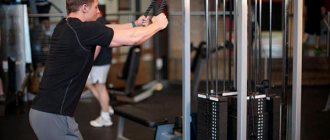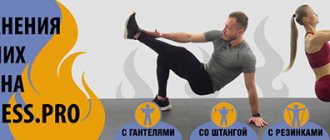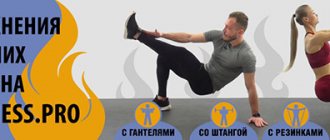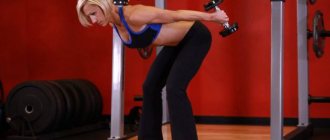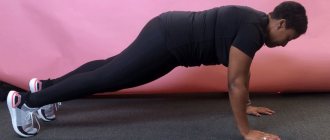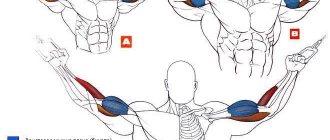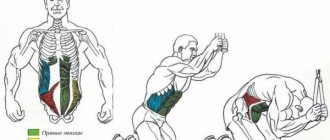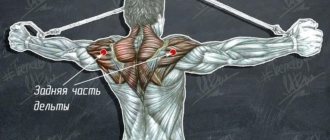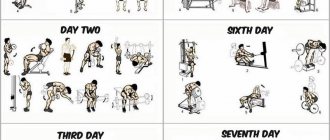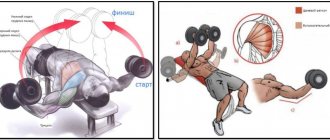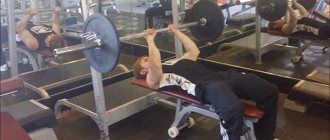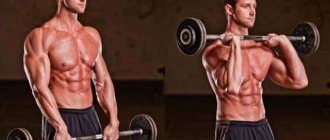Fitness and bodybuildingExercise
Crossover and cable machines provide the variety needed for better muscle development. These exercises have everything you need and a little more.
Author:
Bill Geiger
Why move away from the concept of free weights, the alpha and omega of strength training, and introduce cable exercises? Well, aside from the fact that dropping a 20kg weight plate on your leg can cause hellish pain, there are other good reasons to expand your training horizons.
Unlike free weights, which always pull downward along the direction of gravity, cables can pull in all directions: up and down, forward and backward. This kind of variability opens the door to a completely new world of more effective muscle development.
Standing crossover curls with an EZ bar are a little different than standing curls with an EZ bar. The incline crossover crunch recruits the upper chest muscles a little differently than the incline dumbbell crunch. Raising your arms in front of you on a block is also a little different from lifting dumbbells in front of you.
With this variety of movements, you can get more stimulation for muscle growth, especially if you haven't done any of these exercises before.
Let's look at 10 cable machine exercises and talk about why they should be part of your workout routine.
The best exercises on block machines
Performing exercises on a block machine allows you to diversify your training program and improve progress in building muscle volume.
The peculiarity of such classes is that they are radically different from training with free weights. The blocks in the simulator can be pulled back and forth, to the sides, down and up. Free weights do not provide such flexibility, and muscles do not receive such comprehensive development. The muscles are worked out completely differently when the athlete trains on a block machine.
Lifting the barbell for biceps and performing crossover curls while standing have some differences in the technique of movement, and, consequently, in the impact on the muscles. This also applies to bent over arms, which are done in the simulator, which differs from the usual exercise with dumbbells, since the upper pectoral muscles work somewhat differently.
The variability of positions that block exercise machines provide is the main and main advantage of this sports equipment. Block exercises allow you to stimulate muscle growth. Athletes who previously worked only with free weights achieve especially high results.
Ten best exercises on blocks
They represent a selection of the most effective exercises, which, for one reason or another, disclosed in the presented description of each, should be included in the main training program for increasing muscle mass.
No. 1 Pulley block to the belt from a sitting position
It is a multi-joint exercise that is aimed at training the back using several muscle groups, allowing you to use fairly heavy weights. It, unlike a single-joint one, stimulates the production of much more testosterone and growth hormone in the body of athletes. This has a positive effect on muscle growth. You can work with both the lower and upper grip, as well as with a narrow and wide grip.
It is best to perform this exercise at the end of a workout to develop your back muscles. First you need to work with heavy weights, performing deadlifts, bent-over rows with a barbell, supplementing, if possible, with T-bar rows. Expanding the range of motion is achieved by performing the exercise with one hand.
No. 2 Pulldown of the lower block to the chin
Aimed at working out the shoulder girdle. It is one of the best ways to engage and train the middle fascicle of the deltoid muscle group. Gives the greatest effect with a wide grip. Maximum isolation is achieved by occupying one of three positions - standing with cables (two), on the floor, sitting. Performing with a bar that has rotating handles allows you to relieve the stress on your wrists.
This exercise is best done before single-joint deltoids and after heavy overhead presses. It is often used as a closing dropset when people want to work out the middle fascicles of the deltoid muscles to the maximum.
No. 3 Thrust of the upper block to the chest
Working with free weights involves moving your arms perpendicular to your body. In this back exercise with a block machine, the amplitude is much greater. In addition, the athlete has the opportunity to experiment with different grips and types of bar, which is also an undeniable advantage.
Many athletes perform this exercise as a warm-up for the shoulder girdle, since it has a high range of motion. And if regular pull-ups make it difficult to increase the load, then doing heavy approaches on blocks is much easier. Pulling blocks to the chest can also be done after free weight exercises that follow the warm-up.
No. 4 Bending arms in a crossover from a standing position
This is perhaps one of the best variations of biceps development in such a simulator as a crossover. Its high efficiency is due to the ability to change the height of both the block itself and the position of your own body. This exercise is an excellent choice for those athletes who have a shoulder injury, as it provides the joint with almost complete freedom of movement.
The exercise is not characterized by a high load; it is great for performing in those moments when there is a need to reduce the intensity. It can also be done using fairly heavy weights. The main thing, when reaching muscle failure, is to be sure that the inertia of movement is not involved.
The latter is due to the fact that due to cheating the execution technique is disrupted. This results in an increased risk of injury. Workouts with sets of six or eight repetitions are recommended to be performed with both arms, either a barbell or an EZ bar.
No. 5 Bringing hands together in crossover
Unlike many other chest exercises, it allows you to easily change the angle of resistance. If it is necessary to work the lower part of the pectoral muscles, the blocks are placed at the top, and if the emphasis is on the upper part, then, on the contrary, the blocks are placed at the bottom. Similarly, a change in the point of bringing the hands together is required.
It is made the penultimate or final one in training. When two isolation chest exercises are performed at once during a class, the muscles should be worked from different angles. Otherwise, the loads will be unidirectional, which is not effective.
No. 6 Triset
It is a work on the deltas, which involves swinging to the sides and raising the arms in an inclined position. Recommended for inclusion in training, since block exercise machines were designed specifically for single-joint exercises.
The triset allows you to develop literally every fascicle of the delta, holding the handle and not releasing it. You can spread your arms while standing or bending over, raise them in front of you or swing them to the sides.
This triset usually completes the workout. In what part of the lesson to do this exercise is not of paramount importance. The main thing is to make sure that the work on each beam is the same and not different.
No. 7 Crossover crunches
It differs from similar exercises performed with your own weight in the ability to conduct training with an unlimited number of repetitions, the number of which depends on the goal set for the athlete, as well as the adjustment of maximum loads. Crunches can be performed either on the knees, when the emphasis is on the upper abdominals, or while standing, if it is necessary to work the oblique muscles.
The crossover exercise is done either first or second in training to work the abdominal muscles. Taking a light weight and thereby increasing the number of repetitions, you can do crunches closer to the end of the session.
No. 8 Arm extensions with a rope in a crossover
The reason this exercise is included in the list of the best is that it allows you to get the most out of the long head of the triceps. This is due to the fact that it is much easier to return to the original position in a crossover than when using an EZ bar or dumbbells. This extension can be diversified in several ways, if you stand on your knees or perform it using one hand.
Athletes who work their triceps through multi-joint exercises can do this exercise absolutely at any time during training, after the previous ones have been completed.
No. 9 Abduction and adduction of the arm in crossover
Some athletes believe that performing rotator cuff exercises is purely a waste of time. This is a misconception. This group of muscles and tendons, which together with the deltoid muscles, provides maximum stability to the shoulder joints and also reduces the risk of injury.
It is the lack of exercises that allow you to work the rotator cuff, when the rest of the deltoids are given increased attention, and becomes the main cause of problems. This creates an imbalance in muscle development, which leads to negative consequences and negatively affects the health of the shoulder girdle. To perform abduction and adduction not in a crossover, but with a dumbbell, this must be done either standing or lying down.
You should do five repetitions in each approach as a warm-up to do arm adduction and abduction with light weights.
No. 10 Lower pulley between the legs
The number of leg exercises that can be done on a crossover are limited and ineffective. Rowing with a lower block between the legs is an exception that allows you to get maximum benefit. It is similar to the Romanian deadlift, which allows you to work the posterior chain, including the glutes, lower back, and upper thighs. To get the greatest effect, you need to keep your back straight, your knees bent, and not stretch your shoulders, keeping them to a minimum. Correct technique involves performing all movements exclusively with the hips.
Advantages and disadvantages of working in a vertical block
In continuation of what has been said about the safety of the simulator, I will clarify that the pull of the upper block does not load the spine, but, on the contrary, stretches the vertebrae thanks to the counterweight, which makes the exercise safe for diseases such as hernias, protrusions, pinched nerve endings, but only with moderate weight . Also, training on the upper block will be the right choice for beginners who have not yet strengthened their muscles, and performing barbell rows, dumbbells or other basic exercises can be traumatic.
This does not mean that exercises on a vertical block are completely safe.
It is also possible to rupture the long head of the triceps , which is directly involved in bringing the arm to the chest. This can be caused by muscle overload due to excessive working weight at a time when the back muscles turn off and the triceps take on the entire load.
Following proper exercise technique and choosing the right weight will not only prevent injury, but will also improve your workout performance.
Benefits of the crossover pullover exercise
Often, most lovers of strength training neglect the classic pullover due to the complexity of the technique and its specifics, because the effectiveness of the exercise lies in the maximum stretching of the pectoral muscles and triceps. A standing pullover, on the contrary, does not stretch the pectoral muscles and triceps, as when placing a dumbbell behind the head; the technique is clearer and more accessible due to the anatomy of the exercise, or rather, the option is simpler for most trainees.
In addition, a pullover in a crossover is safer and less traumatic. If the free weight of the dumbbell cannot be held and the muscles are severely stretched, then in the version with the upper block, when muscle “failure” occurs, the athlete only needs to return the plates to their place by lifting the arms higher than the top point of the amplitude. In this case, there is no way to drop the weight on yourself or stretch the ligaments, unless, of course, you make a jerk, which is extremely prohibited with any weight.
Wide grip lat pulldown to chest
The exercise develops back thickness by increasing the load on the middle of the latissimus muscles.
What muscles work
- Latissimus dorsi muscles.
- Teres major muscle.
- Biceps brachii.
- Shoulder muscles.
- Additionally included: trapezius muscle, rhomboid muscle, pectoralis major muscle.
Execution technique
- Place a wide handle on the upper block, grab it from above with a wide grip.
- Lower yourself into the seat with your arms extended above your head. Place your hips under the special fixing rollers.
- Lean your body back slightly, maintaining this position throughout the approach.
- As you exhale, bend your elbows and , using the efforts of your back muscles, bring your shoulder blades together , bringing the handle to the clavicular part of your chest, while protruding your chest, forming a deflection.
- Do not touch the sternum with the handle; fix the tension at the lowest point.
- As you inhale, smoothly straighten your elbows, maintaining the position of your body.
- At the top point, smoothly straighten your arms, gently stretching your shoulder joints, without jerking.
- Repeat the movement.
Upper pulley to the chest in video format
Exercise for the pectoral muscles on a crossover
Features of the exercise
The Crossover Pectoral Exercise is an excellent isolation exercise for the middle and lower portions of the pectoralis major muscle.
Execution technique
- The movement should resemble a tight bear hug. Stand in the center between two pulley machines. Using your hands (palms facing down), grasp the D-shaped handles attached to the free ends of the cables passing through the pulleys attached to the tops of the pulley racks. Place your feet approximately shoulder-width apart so that they fully touch the floor. Bend your torso forward at an angle of approximately 25° relative to the floor. Keep your arms slightly bent at the elbows, palms facing down. From this crucifix-like position, simultaneously bring your arms in front of you, lowering them down until they are level with your hips.
- Hold the position in the final position for a second, tensing your chest muscles as much as possible. Your torso should be slightly tilted forward at the waist. The arms are slightly bent at the elbow joints throughout the entire movement. Slowly return to the starting position. Hold your hands palms down and feel the stretch in your chest muscles. Hold the position in the starting position for a second and then repeat the exercise.
Vertical block row for the head
The advantage of this exercise is to develop the width of the back muscles. This exercise prepares your back muscles for pull-ups and free weight exercises.
What muscles work
- Latissimus dorsi muscles.
- Teres major muscle.
- Biceps brachii.
- Shoulder muscles.
- Brachioradialis muscles.
- Lower part of the trapezoid.
- Rhomboid muscle.
Exercise technique
- Grab the wide handle with a wide grip from above, lower your pelvis onto the seat, straighten your arms above your head, lock your hips under the bolsters.
- Lean your body forward slightly, keeping your back straight.
- As you exhale, move the handle behind your head without touching the cervical vertebrae. Do not lower the handle below your neck. Bring your elbows towards your body by bringing your shoulder blades together, working concentratedly with your back muscles.
- Lock the muscles at the lowest point with maximum contraction.
- As you inhale, slowly straighten your arms above your head.
- Repeat the movement.
Pulldown of the upper block behind the head in video format
Reverse Grip Lat Pulldown
The exercise maximizes the thickness of the back muscles, especially the middle part. In this variant, the biceps of the shoulder are more involved in the work.
What muscles work
- Latissimus dorsi muscles.
- Teres major muscle.
- Rhomboid muscle.
- Pectoralis minor muscle.
- Shoulder biceps.
- Brachial muscle.
Exercise technique
- Place your palms on a wide bar, shoulder-width apart, with a reverse underhand grip, supinating your shoulder joints.
- Lower your pelvis onto the seat, lock your hips under the bolsters, slightly tilt your body back, maintaining the position throughout the approach.
- As you exhale, squeeze your shoulder blades, bringing your elbows towards your body, lower the handle to the upper part of the pectoral muscles, but do not touch them. Concentrating on the work of the back muscles, bring the shoulder blades towards each other as close as possible due to the deflection of the chest, in other words, make the chest a “wheel”.
- Try to perform the pull not with the biceps, but concentrated with the back muscles.
- As you inhale, smoothly straighten your arms at the joints, keeping your torso tilted back.
- Repeat the movement several times.
Reverse grip lat pulldown in video format
Features of a crossover on a block frame
The first rule is that the body must be symmetrical. Often you can encounter a situation where a person deliberately puts one leg in front of the other. This is not worth doing, because... the balance of the body is disturbed - one side becomes slightly stronger than the other.
Shoulders, pelvis, knees and feet should be symmetrical relative to each other. This way we will make sure that there is no imbalance. The strength level of your body is the same on both the left and right.
The second rule is that the tilt of your body and its position should ensure a good stretch of the pectoral muscles at the top point. Start by choosing a position in relation to the machine “closer/farther”. Find the best option for yourself - there are no standard tips here.
Already in the starting position you should feel tension in your chest. Your arms shouldn't just dangle like whips.
The third rule is to record the peak contraction at the lowest point. Take care to pause for a second at the moment when your hands are brought together. A special feature of the block frame is that the lower the handle goes, the harder it is for you to perform the movement. Therefore, the lowest point is the peak of the load and at the same time the maximum contraction of the pectoralis, in terms of amplitude.
The fourth rule is that your chest should be filled with air and pushed forward. Don't arch your chest, creating a sunken chest. At the moment of raising your arms (stretching your chest), fill your lungs with air to the maximum. It’s as if you are creating additional force from within to stretch your chest muscles.
The fifth rule is that the movement occurs in the shoulder joint, the elbows are fixed. The main function of the pectoral muscles is to bring the arms (or more precisely, the elbows) towards each other at the shoulder joint. If you start bending your elbows, helping to overcome the resistance of the blocks, you will simply make the work easier for your pecs, which will not lead to anything good.
There is an opinion that by changing the height of the handle attachment points, you can specifically load different bundles of the pectoral muscles. For example, the handles are at the bottom, and you bring your hands up from the bottom position. This option, in theory, should load the upper part of the pecs.
In practice, a muscle cannot contract partially, in separate bundles or segments. It either contracts completely or does not contract at all. On the other hand, by changing the load angle you force your muscles to adapt to such work differently, and you have the right to count on new microtraumas and some increase in volume.
Close-grip vertical pull-down (parallel)
The exercise works all parts of the latissimus dorsi and teres major muscles using a handle for a narrow parallel grip.
What muscles work
- Latissimus dorsi muscle.
- Teres major muscle.
- Biceps brachii.
- Brachial muscle.
- Brachioradialis muscle.
- Also involved: rhomboid and trapezius muscles, posterior bundles of deltoid muscles.
Features of the technology
- It is necessary to place a handle for a narrow parallel grip or an L-handle on the upper block.
- Grasp the handles and lower your pelvis onto the seat, securing your hips under the bolsters.
- Straighten your arms above your head, lengthening your spine.
- As you exhale, pull the handle toward your upper chest without touching. At the lowest point, it is important to form a deflection of the thoracic region , as if the chest is tending to the handle, bring the shoulder blades as close as possible to each other.
- As you inhale, gently release the tension, straightening your elbows completely.
- Repeat the movements.
Close-grip lat pull-down in video format
Crossover exercises for the upper body.
In our previous article, we already told you about some exercises on a multifunctional crossover trainer. Today we will take a closer look at exercises that allow you to harmoniously develop your upper body. Thanks to the use of this block simulator, you can effectively work out the arm muscles: biceps, triceps, deltoids, brachialis and other muscles, pectoral muscles, back muscles and abs.
Almost all of the exercises listed below are isolating, which means they are designed to deeply work a specific muscle group. Exercises on the upper blocks will help create a beautiful muscle relief. Most often, the crossover is used by athletes who are on a “drying” period, during which the maximum sharpening of the relief occurs. The cable-block system of the simulator allows you to keep your muscles in good shape throughout the entire exercise.
Shoulder and arm workout.
The lat pulldown is a classic exercise for working the triceps. Using a soft rope handle allows you to achieve maximum amplitude and work the deep layers of muscles.
Stand facing the machine and lean your body forward slightly, standing on “soft knees.” To improve resistance, one leg can be placed forward. Maintaining a natural arch in your lower back, straighten your chest and, while inhaling, lower the handle of the exercise machine down towards the front of your thigh. Elbows should be pressed to the body and remain static. Having reached the bottom point of the movement, hold for 1-2 counts. As you inhale, smoothly return the handle to its original position. The exercise is performed 10-15 times for 3-5 approaches.
One-arm lat pulldown
This exercise will allow you to work your back muscles more effectively. When performing the exercise on one side, the weight is not distributed on both hands, but focuses on the target muscles without the help of the stronger hand. Therefore, the craving becomes more concentrated. When choosing a working weight, divide the load with which you perform two-arm rows by two. For this exercise you will need a one-handed handle or a D-handle.
What muscles work
- Latissimus dorsi muscles.
- Teres major muscle.
- Biceps brachii.
- Shoulder muscles.
- Brachioradialis muscles.
- Lower part of the trapezius muscle.
- Rhomboid muscle.
Features of the technology
- Secure and grip the handle for one hand.
- Stand sideways, turning away from your working hand, and lower your pelvis onto the seat, while you can fix one thigh with a bolster, if this is convenient.
- Straighten your arm completely, and exhale, lower the handle to your shoulder, bringing your shoulder blade closer to the center of your back and your elbow closer to your torso. In this case, the shoulder should not turn, the elbow should look down.
- As you inhale, smoothly extend your arm to the starting position and repeat the movement.
- Then turn around in the other direction and repeat the same movement.
Horizontal block row for girls
To ensure effective training and to minimize the risk of injury, several important rules must be taken into account.
To properly work out the latissimus dorsi muscles, it is necessary to bring your shoulder blades together as much as possible during the pull. The horizontal block pull exercise should be performed without jerking. It is important to fix your legs during training. They should not be straightened or bent too much. To make your work easier, you are allowed to swing your body forward/backward, that is, when releasing the weight, you need to lean forward so that your back is slightly rounded
It is important to consider that the amplitude of movement should be small. Horizontal rows in a pulley machine should be performed with the elbows pointing down. They should not be spaced too far apart as this will reduce the effectiveness of the training.
Horizontal block row to the stomach
The presented exercise is used by both bodybuilders and fitness enthusiasts. The horizontal pulldown to the abdomen is aimed at training the latissimus dorsi muscles. This is due to the fact that the exercise not only develops muscles, but also helps get rid of stoop by improving posture. The horizontal block row to the belt is performed on a special simulator, according to the presented diagram:
A V-shaped handle must be attached to the cable of the lower block, thanks to which it will be possible to use a grip when the palms are facing each other. Sit down and place your feet on the footrests, keeping your knees slightly bent. Keep your back straight, bend at the waist and grab the handle. Extend your arms completely and lean back so that your body is perpendicular to your legs. The chest must be directed forward. This will be the starting position (IP). Exhaling, pull the handle towards you until your hands touch your abs
It is important to feel the tension in your back muscles. Hold the position for a few seconds. Return to IP while inhaling.
Horizontal block row to the stomach
Horizontal block row to the chest
One of the variations of the previous exercise, which differs in that the handle is pulled not to the stomach, but to the chest. It is aimed at training the latissimus dorsi muscles. Horizontal rows in the simulator can be performed with different handles. Trainers recommend that everyone choose the option that is more convenient.
- Set the appropriate weight and take the IP, as in the previous exercise, but only the body must be slightly tilted forward.
- As you exhale, perform chest pulls, keeping your body still. Return to IP while inhaling.
Horizontal pull-down on the back
To work your back muscles, you can perform not only the two exercises discussed above, but also one-arm rows. This horizontal back row works well on the middle part. It is best to attach a handle in the form of a loop to the cable.
Assume the IP as in the first exercise, grasping the handle with only one hand
It is important that the palm faces down. Keep your other hand on your belt. As you exhale, pull the handle toward you, rotating your wrist so that your hand is facing your body.
Perform the movement until the hand touches the stomach. After fixing the position, inhaling, return to IP.
Horizontal pull-down on the back
Pull of a horizontal block to the head
The next option trains the shoulder muscles. Pulling a horizontal cable to your head will help relieve tension and spasm in this area. The execution technique is similar to the considered options with the exception of some details.
- Position yourself on the machine, taking the IP position as in the first exercise. Use a cable handle with your palms facing down.
- As you inhale, pull the handle towards your neck so that at the end point your hands are at the level of your head.
- After fixing the position, return to IP while inhaling.
Pull of a horizontal block to the head
Triceps Crossover Crossover Row
Not many women can boast of beautiful arms and in most cases it’s because of weakened triceps. The horizontal row in the crossover is similar to the French press and it involves the three heads of the triceps.
- Sit on a bench, placing it near the cable machine. The head should be directed towards the structure.
- Hold the handle straight with your palms facing up. Bend your arms until you form a right angle at your elbows. Elbows should be in a straight position. Don't drop your hands too low and keep the handle near your head.
- Extend your arms as you exhale, keeping in mind that the movement should occur only in the elbow joint. The part of the arm from the elbow to the forearm should be motionless.
Triceps Crossover Crossover Row
What is better to do – pull-ups or lat pull-downs?
First, you need to understand that pull-ups are the pinnacle of perfection in physical fitness and not everyone can do it for various reasons. While everyone can perform lat pull-downs - both men and girls.
The vertical block row will be an excellent springboard in preparation for pull-ups, since the target muscles in these exercises are almost the same, the only difference is in the strength and capabilities of the athlete.
If we talk about effectiveness, of course, pull-ups involve more muscles, require more strength and endurance from the athlete and bring him closer to results - increased strength, muscles and endurance.
If pull-ups are feasible at least 2-3 times, they should be included in training and developed, and various rows will be additional exercises in the uniform development of the back muscles. Otherwise, rows will be the only way to strengthen your back until the muscles are ready for pull-ups.
Crunches on the upper block
A classic option for working out the abs is crunches. The advantage of this exercise is that with its help you can effectively load all areas of the rectus abdominis muscle. In addition, depending on the variation, a good load can be given to both the oblique and transverse muscles.
Performing this exercise on a block is much more effective than doing it while lying on the floor. This training allows you to remove unnecessary stress from the lumbar region, as well as more effectively work the abdominal muscles.
Squats on the lower block
Crossover squats are a great way to work your legs and glutes while eliminating axial stress on your spine. .
For such training, you will need a special muscle simulator; the exercises are carried out at specialized racks or a power rack.
Don’t forget about the weightlifting belt; it must be put on before performing approaches and be sure to focus on your general well-being.
During exercises with a barbell, it is necessary to maintain a straight and straightened back position, not to slouch or hunch over.
An important rule when doing strength exercises is to have a spotter within walking distance, this can be a coach or an exercise partner.
What muscles are involved during the exercise?
Crunches on a block force all areas of the abs to work, which is their undoubted advantage. During execution, the following abdominal muscles are used:
- straight; oblique; transverse.
The rectus muscle works mainly, while other areas receive a secondary load. In addition to the press, the following muscles take part in the movement:
- lats; shoulder girdle; upper thigh; triceps; diamond-shaped; trapezoidal.
All of them act as stabilizers, helping to maintain the correct body position while working on the block.
Twisting technique
Twisting on the upper block has a fairly simple technique, but it also has a number of important nuances that must be observed.
- Place the required weight on the machine and attach the rope handle.
- Stand facing the machine and take it so that your hands with the ropes are on the sides of your head in the neck area.
- The palms should face each other, and the elbows should be pressed to the body.
- Step back from the machine half a step.
- Slightly tilt your body and head forward.
- From this position, twist downwards, trying to achieve maximum muscle contraction.
- The range of movement is small - the chest will not allow you to go too low.
- When you reach the bottom point, hold for a second, tensing your abs.
- Then, return to the starting position. There is no need to straighten up completely - the abdominal area should be tense throughout the entire approach.
In addition, you can practice on a block while kneeling, for this:
- Follow steps one through four from the previous option.
- Pull the handle and, bending your elbows, lower yourself to your knees.
- Round the body so that the press receives a constant load. The back should not be straightened throughout the entire approach.
- Then, twist your body so that your head drops almost to the floor.
- Achieve maximum muscle contraction by pulling your stomach inward.
- Stay in this position for a second and return to the starting position.
Both types are equally effective. The difference is that when performing this exercise while standing, you will freely include the upper part of your legs in the movement.
Taking the leg back in the crossover block trainer
A movement such as moving the leg back, or scientifically, hip extension, is performed by contracting the muscles of the buttocks and the back of the thigh. Crossover swings allow you to work out the gluteal region as effectively as possible by choosing weights appropriate to your level of training.
Muscles involved
Some of the benefits of performing backswings in a crossover include the following:
- The exercise is aimed at working the gluteus maximus muscles. Additionally, the muscles of the back of the thigh are involved.
- The crossover does not fix the trajectory of the leg movement and the position of the body, so in addition to the target muscles, stabilizer muscles work.
- You can adjust the level of load on the gluteal muscles not only by changing the weight in the simulator, but by changing the position of the body, bending/extending the working leg.
The main load when performing the exercise falls on the buttocks.
This exercise is isolated, ideally, movement is carried out only in the hip joint.
The hip abduction is a fairly simple exercise that even beginners can do.
Execution technique
Backward leg swings in a crossover can be performed while standing or with emphasis on your hands and knees. Let's first consider the first, most popular option:
- Stand facing the support of the block machine.
- Attach a cuff to the cable of the lower block, which will allow you to secure the cable to your foot or ankle. Place your leg through the cuff.
- Comfortably grasp the support of the simulator with your hands and secure the body. The pelvis should be strictly above the foot of the supporting leg.
- Bend your working leg slightly and swing back. Remember that the gluteal muscles are able to move the straight leg back 10-15 degrees from the vertical line. Then the back muscles come into play. Therefore, if you keep your body straight, do not move your leg too far and do not bend.
- Do not turn your hip outward; the movement is performed strictly backward.
- At the top of the movement, pause briefly and lower your leg to the starting position.
If you keep your body straight, you don’t need to move your leg far.
By tilting your body forward, you can adjust the amplitude of your swing. Accordingly, the lower you bend, the greater the amplitude of leg movement will be. Accordingly, the gluteal muscle will stretch more and work more efficiently. Do not forget to control your back - a natural arch in the lower back is allowed, but nothing more. There is no need to arch your back.
Tilt of the body allows you to increase the amplitude of movement.
Hip extension from a position on hands and knees looks like this:
- Secure the end of the cable to the foot of your working leg using a cuff or any handle that is comfortable for you.
- Facing the support of the machine, lower yourself into a squat and move to a standing position on all fours with a straight back and emphasis on your palms and knees. You can stand on the floor, placing a towel or mat folded several times under the knee of your supporting leg, or use a horizontal bench. This is the starting position.
- Extend your working leg and lift your heel up. Hold for a second, concentrating on tightening your glutes.
- Return to the starting position.
Variation of the exercise using a horizontal bench.
Incorporating exercise into the training process
Leg kicks should be performed at the end of a complex workout for the hips and buttocks. It is well suited for finishing off the gluteal muscles.
Choose light or medium weight. You should be able to do 2-3 sets on each leg for 12-15 repetitions.
Common mistakes when twisting
The simpler the exercise is, the more mistakes can be made in it. The same applies to crunches on the upper block, where a number of stupid mistakes are made.
The main mistake that beginners make is that they do not twist, but bend. If you do not twist your body, then all the stress will go to the lumbar region, while the abs will receive almost no load.
In addition, keep an eye on the following points:
- During execution, you must ensure that your back is rounded from the shoulders to the lower back. If you do not round your back enough, the load will transfer from the abs to it. The lower back itself should not arch, otherwise there is a risk of injury.
- The exercise should be performed continuously. That is, you should only linger at the point where maximum tension is achieved. It is permissible to relax the muscles only after completing the approach.
- At the lowest point, the elbows should reach the level of the knees. At the same time, you need to ensure that your hands are not involved in lowering the weight. They must only hold the handle, while all movement is carried out exclusively by the work of the press.
- The torso must remain in one position at all times. If you swing, your hips will also be involved in the movement.
- Don't use too much weight. This is an unpretentious exercise, designed primarily for maintaining the correct technique and number of repetitions.
One of the important advantages of this exercise is that it is equally suitable for both beginners and experienced athletes. By varying the weight and number of repetitions, you can achieve incredible abdominal pumping.
In addition, crunches performed on a block are a fairly safe exercise. If you follow the technique correctly, you will almost completely eliminate the lower back from the movement. This means you won't overload it.
It is best to perform cable crunches at the end of a training session. In order for it to bring you even more benefits, stretch your abdominal muscles after it.
